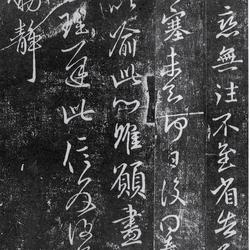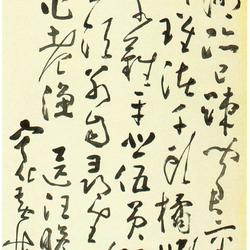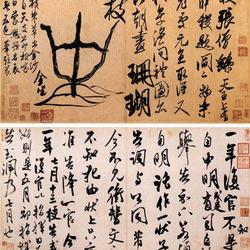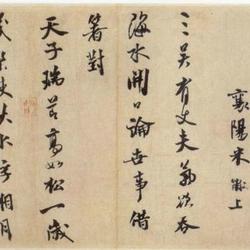Overview of Dharma Tips
Introduction
"Notre Dame Notes" was written by Huaisu, a wild monk in the Tang Dynasty, for Our Lady of Dongling.
"Notre Dame Notes" was written in the ninth year of Zhenyuan of the Tang Dynasty (793). It is generally believed that it was written by Huaisu when he traveled from his hometown of Hunan and passed through Yiling Town (anciently known as Dongling) in Jiangdu in his later years. The content describes the story of the two fairies Du and Kang in the Jin Dynasty who secretly ascended to heaven and blessed the people of Jianghuai.
description
Cao Zhao of the Ming Dynasty's "Essays on Gegu: Notre Dame Tie": "Huaisu's cursive script is quite difficult to read. In the ninth year of Zhenyuan, the stone was carved in the fifth month of Guichou. In the third year of Yuanyou of the Song Dynasty, the stone was carved with Wuchen mold and was learned in Xi'an, Shaanxi. ." Ming Wang Shizhen's "Huai Su's Notre Dame's Calligraphy": "All Su's calligraphy are thin and exposed, but this book is uniquely balanced, stable, mature, and wonderful."
Explanation of Dharma Notes
The Holy Mother's heart was filled with sorrow, so she accepted the teachings of the Shangqing Dynasty and became a saint. Those who admire the immortal level have far-reaching inspiration, and those who have great achievements are quick to respond. There was a real person, Liu Jun, who came down to the court, riding on a lin. Liu Jun's name is Gang, and he values truth. The Holy Mother's Dao should be recorded in the treasure, and then the immortal was given the secret talisman, and the precious medicine was used as a bait. Then the divine rituals were transformed, the skin and bones were slender, and she was freed from the vulgar world and despised the love of the world. Mrs. Du was very angry and blamed my wife for her rituals, but the Holy Mother was silent and ignored her. After a long period of litigation, I was detained in Youyili, and suddenly a fairy in colorful clothes descended from the sky. Qingyun came to the door, and I called the two girls, who quietly climbed up together. When the rising sun first shines, you stand straight up, the banners are shining brightly, shining brightly in Morun, the music is special and fragrant, and you can't rest until you have no time. Emperor Kang thought that the revival was auspicious, so he ordered a fairy palace to be built in his place to celebrate the auspiciousness. Because of the name, it is called Dongling. The Holy Mother's home is in Guangling, the immortal is in Dongtu, and she is in Dongling. The two daughters were promoted to the throne, and they were called Holy Mother Yan. Sui Yu is respected, and the true ritual is beautiful. Returning from far and near, they poured money into the Yangtze and Huaihe Rivers, floods, droughts, and plagues, all prayed for help, and the gods responded with great success, and the people used it well. If a treacherous thief does not bring anyone to blame, then there will be birds flying in his hut. Once the spiritual sign has descended, the crime will be punished. Between the wells, there is nothing hidden. Since the Jin Dynasty, when he was about three hundred years old, he was a servant of the elite, and his chariots and disciples rushed to his subordinates. When Emperor Yang moved to the east, there were many taboos in his fortune, and Taoist companions were strictly prohibited. The nine saints of Tianyuan Pi Cheng, Mu Yang Zhidao, and the real palace and secret palace were built without any choice. The situation is clear and can be heard, and the Tao is transformed into people. Although the trees and shades are desolate, people gather to offer prayers and offerings, but the building has not been restored, and the senior citizens are sad. Who is interested in it? Guangdong is famous for its virtues. From his uncle Huainan Jiedu, he was the Minister of Rites and the Supervisor of the Army, Guo Gong of Taiyuan. The ninth year of Zhenyuan was in the fifth month of Guiyou.
Related Reading
Legend of Our Lady of Dongling 1
"Book of the Later Han Dynasty - Chronicles of Prefectures and Countries" records: "The woman Du Jiang, whose left path is connected to the gods, was regarded as a demon by the county, imprisoned and shackles, and her soldiers were deformed. They did not know where they would end up, so they took the form and established a temple in its place, named Dongling. Holy Mother”. "Youyang Zazu" records: "The Our Lady of Dongling in Yangzhou, the temple's owner, the female Taoist Kang Zixia, has served the Virgin for many years. Once she ascends in the daytime, she turns into a white dragon and goes away." According to this statement, the Fairy Temple is dedicated to the female Taoist priest Du Jianghe. Her apprentice Kang Zixia. She understands medicine and weather, and often treats diseases for the masses. She is also good at knowing the weather and happy to serve farmers, and is deeply loved by the people. However, the government believed that the female Taoist priests were deceiving the public with their evil words, so they were imprisoned and transformed into immortals in prison. The people built temples for them to worship and called them "the Holy Mother of Dongling". The "Fairy Temple" has a long history and is famous far and wide. Therefore, the temple name replaced the place name, and Caijiazhuang became the Fairy Temple.
The Fairy Temple is located in Hebei. In today's Jiangdu Rice Factory, boats must pass in front of its gate. The temple is large and spacious, with three entrances in front and back, including a hall, a building, and a monastery. In the early days of liberation, there was still one entrance house, which was later rebuilt into a rice factory and demolished. There is also a Notre Dame Shrine in Yiling Town, which is also dedicated to the Second Fairy Dukang, also known as Our Lady of Dongling. Some say that the Dongling Holy Mother Temple was originally located in Yiling and then moved to Jiangdu Town, or that it was first established in Jiangdu Town and then moved to Yiling. Which one is more accurate is left to experts for verification.
Legend of Our Lady of Dongling 2
After reading ancient books recently, I found that in ancient times there was a Madonna of Dongling that was circulated among the Jianghuai River. Regarding the Virgin of Dongling, Zhang Hua from the Western Jin Dynasty has recorded it in "Natural History". Ge Hong of the Eastern Jin Dynasty recorded it in detail in "The Legend of Immortals". He said: "Our Lady of Dongling is from Hailing in Guangling (today's Yangzhou). She is a Du family and learned Taoism from Liu Gang. She can change her shape and become invisible. Du does not believe in the Tao and is often angry. Our Lady saves people from illness, or Something was achieved. Du was even more angry and sued the official, saying that the Virgin Mary was a treacherous demon and neglected household chores. The official took the Virgin Mother and sent her to prison. After a while, she flew away from the prison window, and everyone saw her. She turned high into the clouds and stayed there. A pair of shoes were placed under the window. Therefore, temples and shrines were erected near and far. The people served him and prayed for them to be effective."
The Holy Mother Monument written by Huaisu of the Tang Dynasty said that the Holy Mother was: "The origin of the family is Guangling, and the immortal is in the east, and it is called Dongling Yan." It also says, "I have returned from far and near, wandering across the Yangtze and Huaihe Rivers, floods and droughts, and praying for everyone, and the gods have answered. , people use it well."
Appreciation of works
Compared with Huaisu's other posts, "Notre Dame's Calligraphy" is a more standardized cursive script. For example, Huaisu's representative cursive work "Zi Xie Tie" is characterized by rapid continuous strokes, twists and turns, sharp turns to gain momentum, vertical and horizontal rotations, thunder and lightning, and independent brushwork. As for "Virgin's Notes", the pointillism is simple and concise, with less continuous threads. Judging from the age of writing, "Notre Dame Notes" is Huaisu's masterpiece in his later years. It is extremely splendid, has returned to plainness, is calm and frustrated, and is free of anger. The writing style is smooth and should be regular. Comparing the two, it should be said that "Autobiography" is emotional and has real interest based on emotion. The whole article is like a long river rushing down, making people feel that it is Huaisu's frank and passionate reflection on his personal life experience and encounters. Catharsis; and "Mother's Letter" should be said to be rational, based on the heart, the whole text is like a petal of heart fragrance, silently and piously expressing Huaisu's solemnity and respect for God. When Wang Shixian of the Ming Dynasty commented on "Notre Dame's Tie", he said: "All the Tie of Master Su are thin and exposed, but this book is uniquely balanced, stable and mature." Liang Gao of the Qing Dynasty wrote a more comprehensive review in "Chengjin Zhaiji Wenlu" This point is clearly explained: "Huaisu's "Notre Dame Tie" is round and ancient, with many chapters and chapters. It is a pen of his later years. It is better than "Autobiography", which is more vertical and horizontal, but this is ancient and natural. Huaisu "The Holy Mother" is the best among all his paintings." The strong, round, and gentle lines of "The Holy Mother's Painting" can be seen from his inheritance with the "Two Kings" (Wang Xizhi and Wang Xianzhi's father and son).


















